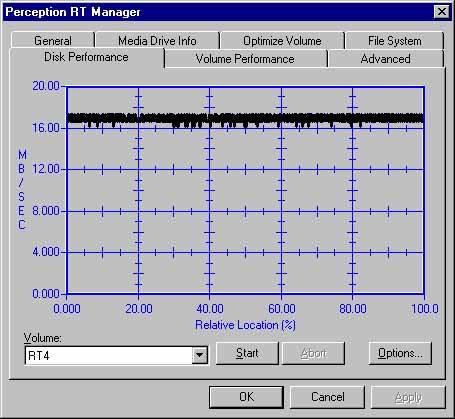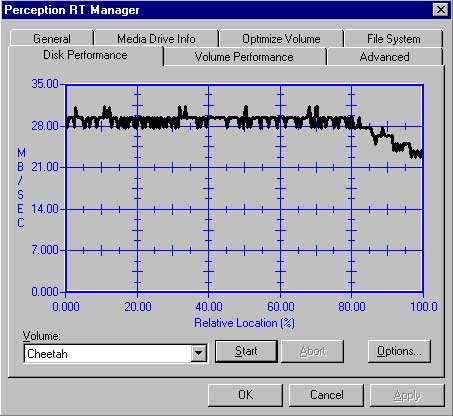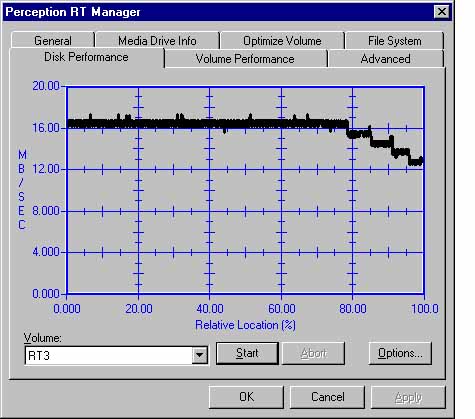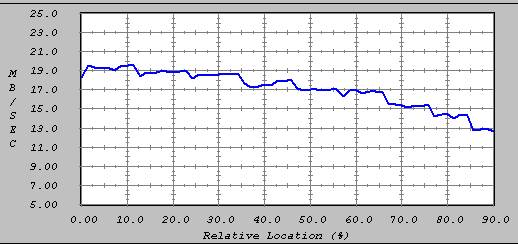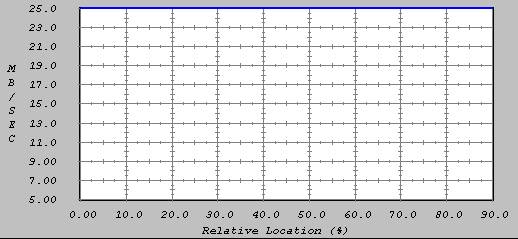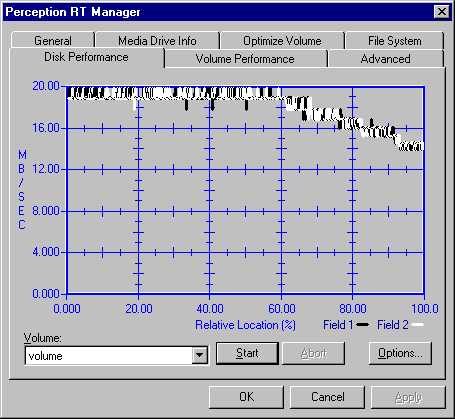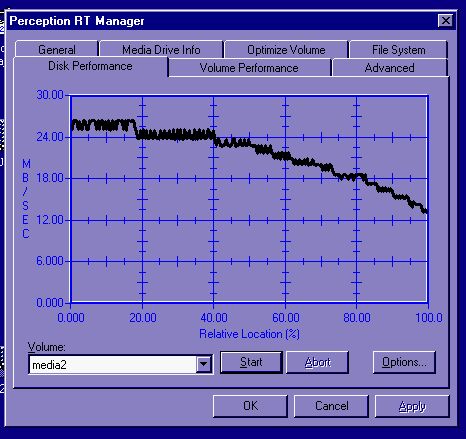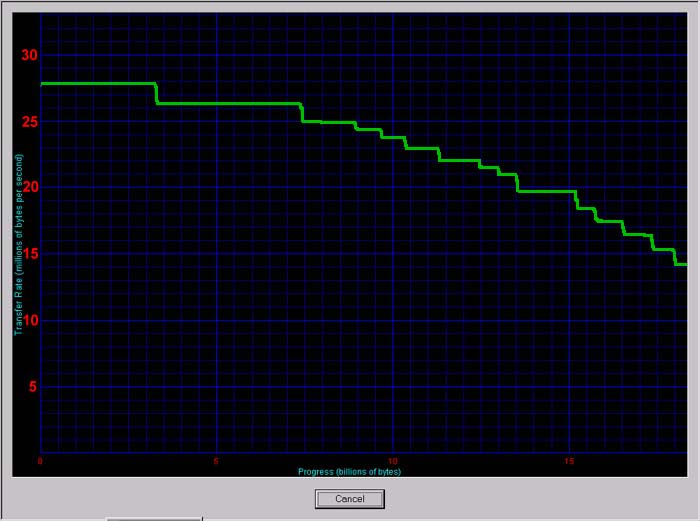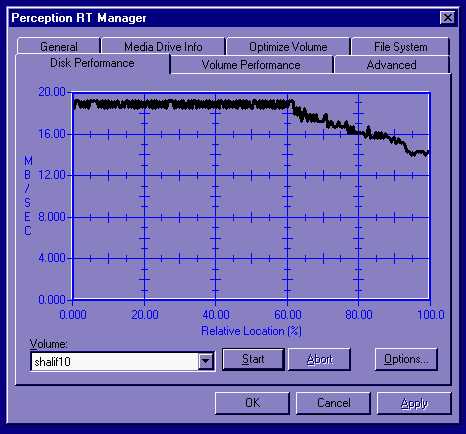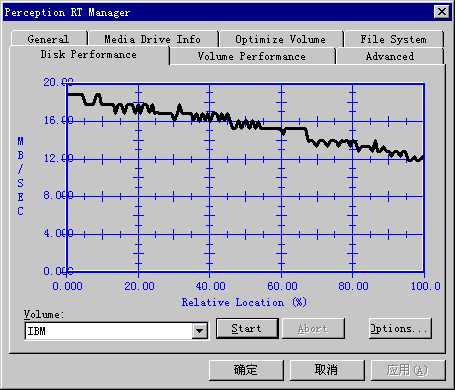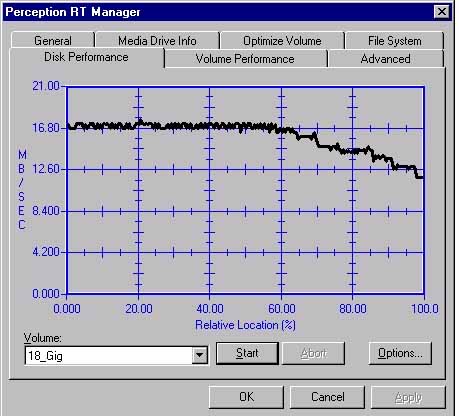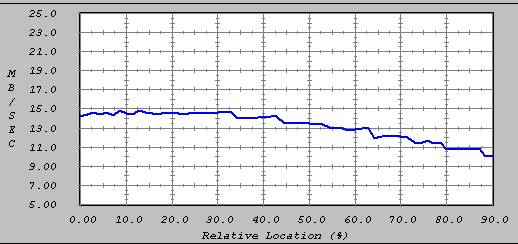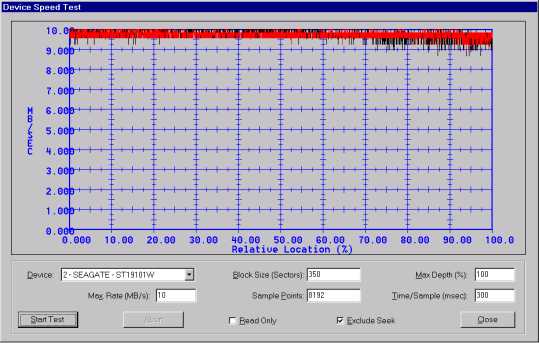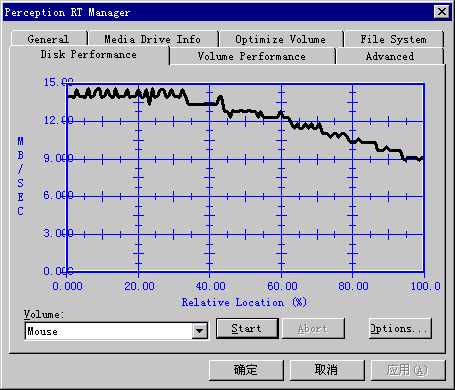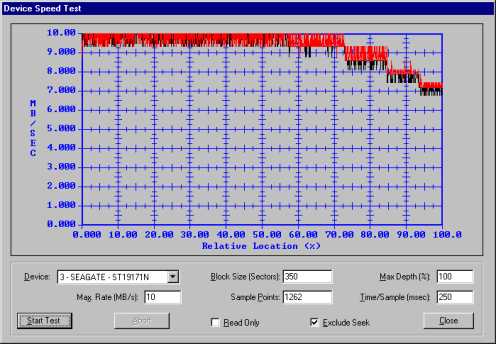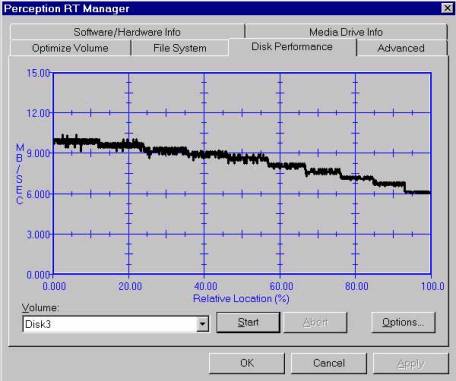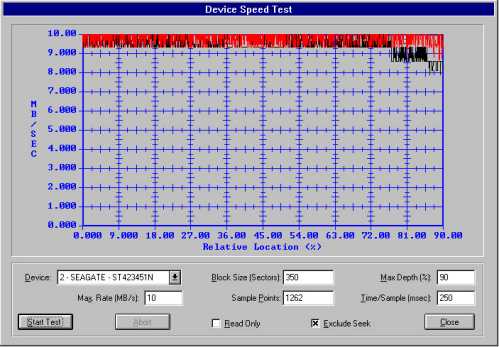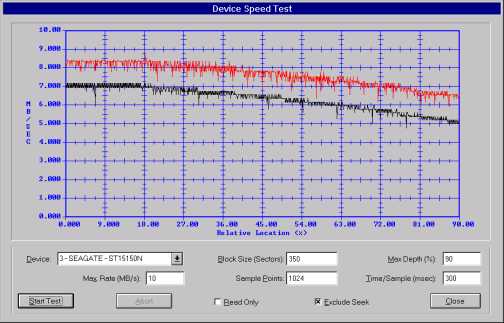
Old Hard Drive Test GraphsNOTE: Graphs that have a WHITE & BLACK lines are Stripped sets with the white line representing one drive & the black line representing the other drive. On graphs that have RED & BLACK markings, the RED represents the WRITING (recording) speed & the BLACK represents the PLAYBACK speed.
73 Gigabyte Seagate Cheetah Model (ST373405LW) (10,000 RPM) tested on PVR-RT. It's an UltraWide3 LVD, or UltraWide non-LVD 68 pin.
18.4 Gigabyte Seagate Cheetah Model 36 XP (ST318405LW) (10,000 RPM) (third
generation) tested on PVR-RT. It's an UltraWide3 LVD, or UltraWide non-LVD 68
pin, 4 MB of buffer ram.
New 50 Gigabyte Seagate Barracuda ST150176LW UltraWide2 SCSI drive (7200 RPM) tested on PVR-RT. This drive is 1 & 5/8" thick (half height) & has 1 meg of cache (firmware 0002). Runs cooler than a 10,000 RPM drives. Note that this drive is not approved by DPS for use on the PVR-RT (I have confirmed that it has minor problems), but it is approved for use on the Reality.
18 GigaByte Seagate Barracuda ST318275LW UltraWide2 drive (7,200 RPM)(1 meg of cache) 1" (low profile) on the Reality NLE hardware.
Medea VideoRaid RT 6/150 drive, 150 GigaBtyes This is an array product made of 6 IDE drives & a SCSI Raid 0 interface in a case with power supply that can hook to an Ultra Wide2 controller. Performance can go higher than graph is able to show (55 MB/sec minimum). I've heard that price is less than SCSI drives of similar capacity & speed. I've started to hear of a number of people who may be having problems with Medea drives, so buyer beware. For more information http://www.medeacorp.com
18 GigaByte stripped pair of IBM UltraStar 18ZX DRVS-3018510 drives (10,000 RPM) (4 megs of cache)(firmware 0140) tested on PVR-RT. This drive is 1 & 5/8" thick (half height) & is UltraWide2.
The following is an OEM version of the 18 GigaByte IBM UltraStar DRVS18V (model 11S08L8619YM1022015252) (10,000 RPM)(4 megs of cache)(firmware 0140) which is suppose to be an identical version to the UltraStar 18ZX DRVS-3018510 shown directly above (according to IBM & the distributor Globelle). However you can clearly see that it is substantially slower in the first 77% of the drive (3 meg/second slower). A talk with an IBM tech revealed that this drive is sold through "Distributor" channels & is suppose to be identical, BUT may actual have the MODE PAGE SETTINGS set differently. This drive is 1 & 5/8" thick (half height) & is UltraWide2.
The following is a UltraWide2 brand new drive which became available in late June 99. It's an OEM version of the 18 GigaByte IBM LZX UltraStar DMVS18V (model 11S09L3905YM1012012191) (10,000 RPM)(2 megs of cache)(firmware 0100). This drive is 1" thick because it has a higher packing density than the drives above. This is suppose to be the new & improved version compared to the two models above (18ZX), but if you look at the gray graph, the speed is lower (not higher) at the outside of the drive (something I've never seen before). When tested on the PVR-RT, it looks to me like this drive is being throttled back by it's internal mode settings & I'm wondering why. It should be as fast or faster that the drive at the top of this list, yet it is 6 meg/second slower through most of the drive. WHAT'S WRONG WITH THIS PICTURE. To read what IBM has to say about this NEW & improved drive go to http://www.storage.ibm.com/hardsoft/diskdrdl/prod/ultrastar.htm & click on Ultrastar 18LZX The purple graph below is supposedly the very same drive but measured on another PVR-RT system. Results of the same model IBM drives seem to vary from batch to batch (Seagate drive results are consistent). IBM suggested I try the Winspeed99 drive test utility which I did & is posted below (black version). Notice how it is a much higher speed rating than the gray drive speed test graph in the DPS PVR-RT utility & similar to the purple graph.
The following is a UltraWide2 brand new drive which became available in late
June 99. It's a 36 gig OEM version called the IBM ZX UltraStar
DMVS36V (model 11S09L3903YM1022004358)
(10,000 RPM)(2 megs of cache)(firmware 0100). Notice that this drive has the
same poor response curve as the 18 gig LZX above. This drive does work correctly
on the PVR-RT.
9 Gigabyte IBM DRVS 9 drive
18 GigaByte IBM UltraStar 18ES drive (7,200 RPM) on PVR-RT
18.2 GigaBytes Quantum Atlas IV Part # KN18L011
18 GigaByte stripped pair of Seagate Barracuda ST118273W UltraWide drives (7,200 RPM)(1 meg of cache) half height on PVR-RT. White line is for one drive & black line for the other drive. Same ST118273W model on the Reality NLE hardware
9 GigaByte stripped pair of Cheetah drives (10,000 RPM) on PVR-RT White line is for one drive & black line for the other drive
9 GigaByte ST19101W Seagate Cheetah UltraWide Drive (10,000 rpm) tested on the PVR.
9 GigaByte Seagate Barracuda ST39173LW UltraWide2 drive (7200 RPM) on PVR-RT.
9 GigaByte stripped pair of Seagate Barracuda ST19171W UltraWide drives (7200 RPM) on PVR-RT, White line is for one drive & black line for the other drive
9.1 GigaByte ST19171N Seagate Barracuda Drive (7,200 rpm) tested on the PVR.
9 GigaByte single 3391WAV Micropolis Tomahawk drive with 2 meg of RAM (7200 RPM) on PVR-RT
9 GigaByte 3391AV Micropolis Tomahawk Drive with 2 Meg of RAM (7,200 rpm)
23 GigaByte ST423451N Seagate Elite Drive
4.3 GigaByte ST15150N Seagate Barracuda Drive, RAM partitioned into 2 segments.
By Doug Hembruff. |
Home Page & Power Products | Tutorials | Opinions | Legacy Video Production | Contact Info
